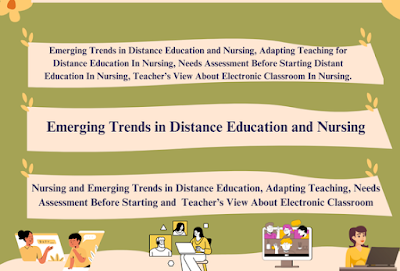The Emerging Trends in Distance Education Adapting Teaching Needs Assessment Before Starting and Teachers View About Electronic Classroom In Nursing. Nursing educators often have a positive attitude toward e-classrooms, recognizing their potential for flexible learning and access to advanced educational resources.
The Emerging Trends in Distance Education Adapting Teaching Needs Assessment Before Starting and Teachers View About Electronic Classroom In Nursing
Emerging trends in distance learning include the integration of new technologies such as VR, AR, and MR, as well as the use of big data and blockchain. Before implementing a distance learning program, it is essential to conduct a needs assessment to ensure it meets the needs of both faculty and students. Nursing educators often have a positive attitude toward e-classrooms, recognizing their potential for flexible learning and access to advanced educational resources.
A variety of innovative technologies are used in nursing education, such as virtual reality, simulations, and online learning platforms. These technological advancements promote student engagement, creativity, and critical thinking through immersive virtual learning experiences.
Virtual reality is an emerging technology for nursing education. This technology allows visual, motor, and auditory immersion in a virtual environment, thus mimicking reality. Virtual reality can be an effective educational tool for nursing educators to meet the learning needs of nursing students.
Emerging Trends in Distance Education and Nursing
Emerging Trends in Distance Education In the evolving landscape of distance education, Massive Open Online Courses (MOOCs) have emerged as a significant trend. MOOCs offer large-scale online courses that are often free of charge, attracting thousands of students worldwide (Bonvillian & Singer, 2013). These courses have introduced innovative business models, such as offering “badges” or certificates for course completion (DeSilets & Dickerson, 2013; Pirani, 2013). Despite their promise, MOOCs are still in development, with recent years witnessing the launch of the first accredited MOOC-based degree programs outside the healthcare sector (Mazoue, 2014). The concept of MOOCs for credit continues to evolve rapidly, reflecting the dynamic nature of online education.
Another critical factor influencing distance education is regulatory compliance. Since 2010, U.S. Department of Education mandates required educational programs to secure state authorization for delivering courses across state lines (Poulin & Boeke, n.d.). Although the federal mandate has been vacated, state regulations requiring authorization for distance education programs remain in effect. Institutions planning to offer programs across state borders must navigate these regulations carefully to ensure compliance and maintain quality education standards.
Adapting Teaching for Distance Education in Nursing
Adapting teaching strategies for distance education in nursing requires a thoughtful approach. While the technology and methodologies vary, some core principles apply universally. Effective distance education in nursing involves modifying teaching styles and materials to suit online formats (Bower et al., 2014). Key strategies include:
- Collaborative Planning: Team-based planning rather than individual efforts enhances course development. Emphasizing content over process and using a cohesive syllabus are crucial for effective distance education planning.
- Faculty Roles: In a distance education setting, faculty members act as facilitators or guides. It is essential to foster an environment that supports active learning, provides feedback, and encourages interaction among students and instructors (Keengwe & Kidd, 2010).
- Technological Proficiency: Faculty need a baseline level of technological skills and organizational planning to effectively deliver distance education. Providing ample support for faculty to adapt to new technologies is also important.
Needs Assessment Before Starting Distance Education in Nursing
Before launching a distance education program, conducting a comprehensive needs assessment is vital. This involves analyzing the demand for the program in the target area to ensure sufficient enrollment. Factors to consider include:
- Market Demand: Evaluate the perceived need and demand for the program. Understanding the local demand for nursing education will help in planning and implementation.
- Technology Access: Assess the availability of technology and high-speed Internet among the target audience. Since many distance education technologies rely on high-speed connections, it’s crucial to determine if potential students have adequate access.
- Marketing and Promotion: Once the program is launched, implementing a marketing plan is essential to attract students. Ongoing student satisfaction is a key indicator of program success and can help in promoting the course.
Teacher’s View on Electronic Classrooms in Nursing
The role of electronic classrooms in distance education is growing. While traditional classrooms remain important, the integration of advanced technology is reshaping their use. Here are some considerations:
- Investment in Technology: Modern electronic classrooms are equipped with multimedia systems, including presentation systems, high-speed data networks, and interactive tools. These investments are crucial for effective distance learning.
- Flexibility and Accessibility: Portable video conferencing and audiovisual equipment offer flexibility and can be used across various instructional spaces. This technology allows faculty to teach from different locations, including their homes, provided they have access to necessary equipment and technical support.
- Infrastructure and Support: Institutions must invest in infrastructure, including data networks, computing resources, and technical support. Continuous faculty development and orientation to technology are essential for successful distance education.
- Formative Evaluation: Regular formative evaluations of teaching strategies and student interactions help maintain a strong learning focus. This approach ensures that both teaching and learning processes are continuously improved, promoting a positive and effective educational experience.
In conclusion, adapting to the emerging trends in distance education requires a strategic approach to technology, faculty support, and regulatory compliance. By addressing these factors, institutions can enhance their distance education programs and meet the evolving needs of nursing students.
Read More:
https://nurseseducator.com/didactic-and-dialectic-teaching-rationale-for-team-based-learning/
https://nurseseducator.com/high-fidelity-simulation-use-in-nursing-education/
First NCLEX Exam Center In Pakistan From Lahore (Mall of Lahore) to the Global Nursing
Categories of Journals: W, X, Y and Z Category Journal In Nursing Education
AI in Healthcare Content Creation: A Double-Edged Sword and Scary
Social Links:
https://www.facebook.com/nurseseducator/
https://www.instagram.com/nurseseducator/
https://www.pinterest.com/NursesEducator/
https://www.linkedin.com/in/nurseseducator/
https://www.researchgate.net/profile/Afza-Lal-Din
https://scholar.google.com/citations?hl=en&user=F0XY9vQAAAAJ

Абсолютно стильные новости моды.
Все эвенты самых влиятельных подуимов.
Модные дома, бренды, haute couture.
Приятное место для стильныех хайпбистов.
https://rftimes.ru/news/2024-08-14-7-samyh-kultovyh-veshchey-ot-balenciaga
хорошо